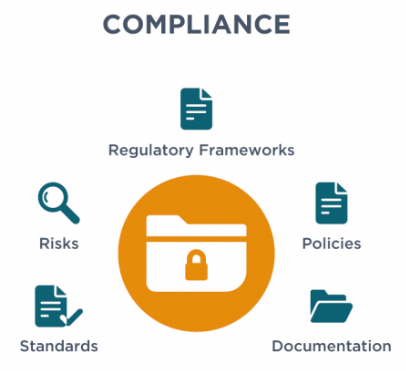HyperLeap helps companies set up Regulatory Compliant System. IT Regulatory Compliance encompasses various aspects related to standards, risks, regulatory frameworks, policies, and documentation.

Standards
Standards are guidelines or benchmarks that organizations can adopt to ensure compliance with specific requirements. They provide a framework for best practices and help organizations meet industry-specific regulations. For example, ISO/IEC 27001 sets standards for information security management systems, while PCI DSS outlines requirements for handling payment card data. Compliance with standards helps organizations demonstrate their commitment to security, quality, privacy, and other relevant areas.
Risks
IT Regulatory Compliance involves assessing and managing risks associated with information technology. Risks can arise from vulnerabilities, threats, regulatory non-compliance, data breaches, or operational disruptions. Organizations need to identify potential risks, evaluate their likelihood and impact, and implement appropriate controls to mitigate them. Risk management frameworks, such as NIST Cybersecurity Framework or COSO Enterprise Risk Management, provide guidelines for identifying, assessing, and responding to risks in the context of IT compliance.
Regulatory Framework
A regulatory framework encompasses laws, regulations, and guidelines that organizations must comply with to ensure legal and ethical practices. These frameworks vary based on the industry, geography, and the nature of the organization’s operations. For example, in the financial sector, organizations must comply with regulations such as Sarbanes-Oxley Act (SOX) or Basel III. Understanding the specific regulatory requirements applicable to the organization’s industry and region is essential to establish compliance measures and ensure legal and ethical practices.
Policies
Policies are documented guidelines that define an organization’s approach to specific aspects of IT Regulatory Compliance. These policies outline the expected behavior, responsibilities, and procedures for ensuring compliance. For example, an information security policy may specify requirements for access control, data classification, incident response, and employee training. Policies should align with regulatory requirements and industry standards and be regularly reviewed and updated to reflect changes in the regulatory landscape and business environment.
Documentation
Documentation plays a crucial role in IT Regulatory Compliance. It involves maintaining records of policies, procedures, controls, risk assessments, audits, and incident reports. Documentation provides evidence of compliance efforts and helps demonstrate due diligence to regulatory bodies, auditors, and stakeholders. Well-organized and comprehensive documentation enables organizations to track compliance measures, address non-compliance issues, and facilitate internal and external audits.
IT Regulatory Compliance encompasses various components. Standards provide guidelines for best practices, risks need to be assessed and managed, regulatory frameworks define legal requirements, policies establish guidelines for compliance, and documentation provides evidence of compliance efforts. By addressing each of these aspects, organizations can establish effective IT Regulatory Compliance programs to ensure adherence to applicable laws, regulations, and industry standards. HyperLeap helps companies set up Regulatory Compliant System.
